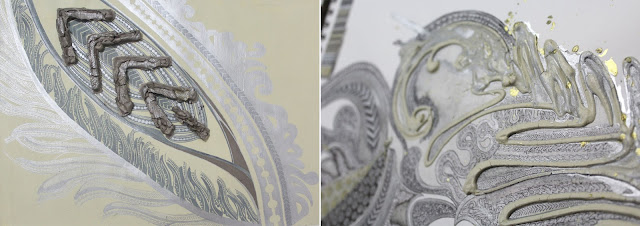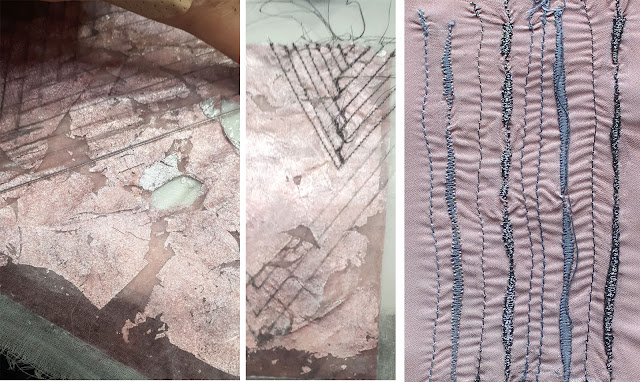Drawing to embroidery
Drawing to Embroidery
At this stage, it was very challenging for me to shrink down
all the elements from my drawings and work with something that will give my
work a meaningful direction.
I had been looking for some dominant colours that would work well with others i.e. many colours from the pink colour palette worked with this much warmer colour.
Theoretically, this muted and subtle colour is most likely to let both the gold and silver come in my work and it will balance the colours out without having to choose one metallic i.e. gold or silver.
As it can be seen in fig 1, upon trying, I believe the acrylic paint mix with these two
metallics, worked very well. Therefore, I could make a hypothesis that now I
could try something other than just drawings on this paint, in order to develop
my work.
Before deciding, what colours I
wanted to take from my drawings to the actual embroidery samples, I decided to
scan and experiment digitally, manipulate things around change angles, colours
and layers. From this, I manage to get a few very interesting digital prints
especially the cracked metallic background one, fig 2, which I couldn’t have achieved with painting or
dying the fabric.
·
The colour
·
Designs/Pattern
·
The animals structure
Out of all the colours that I
mixed with the metallic powder paint, I liked this creamy colour for various
reasons:I had been looking for some dominant colours that would work well with others i.e. many colours from the pink colour palette worked with this much warmer colour.
Theoretically, this muted and subtle colour is most likely to let both the gold and silver come in my work and it will balance the colours out without having to choose one metallic i.e. gold or silver.
 |
| fig 1 |
·
I could try laser cutting my drawings.
·
Or do
something 3D with the metallic powder paint, as it gives a dimension
contrasting to the flat drawing, which seems to work very well.
 |
| fig 2 |
Now I needed to extract something very simple from my
drawings to work on top of these sublimation prints. I decided to go for this diagonal line from this drawing, shown in fig 3 to be a constant element in my embroidery work.
This could help make my work look more focused and one directional.
My next step will be to research more on embroidery techniques, mainly on this pattern darning technique.
 |
| Pattern Darning The Manchester Museum |


Comments
Post a Comment